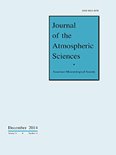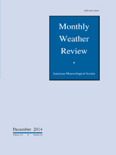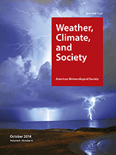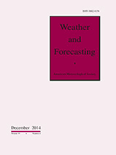
Journal of Operational Meteorology
Scope & Guideline
Exploring the Intersection of Science and Forecasting
Introduction
Aims and Scopes
- Operational Weather Forecasting:
The journal emphasizes methodologies and technologies that improve weather forecasting, including the use of advanced modeling techniques and satellite imagery. - User Engagement and Communication:
Research on how weather information is communicated to the public, including the effectiveness of various platforms such as social media and mobile applications. - Severe Weather Analysis and Preparedness:
A focus on understanding severe weather events, including tornadoes and hurricanes, and enhancing preparedness strategies for these events. - Environmental Impacts on Weather Patterns:
Investigations into how environmental factors, such as soil moisture and terrain, influence weather phenomena and forecasting accuracy. - Innovative Tools for Meteorological Applications:
Development and evaluation of new tools and systems that aid meteorologists and emergency managers in making timely and informed decisions.
Trending and Emerging
- Integration of Technology in Forecasting:
There is a growing trend towards the use of synthetic satellite imagery and convection-allowing models, showcasing the importance of advanced technology in improving forecasting accuracy. - Public Engagement and Decision-Making:
Research focusing on public perceptions and decision-making in response to severe weather forecasts is on the rise, reflecting an increased emphasis on effective communication and community preparedness. - Environmental Influences on Weather Events:
An emerging theme is the exploration of how environmental factors, such as soil moisture and terrain, impact severe weather events, indicating a deeper understanding of the interplay between environment and weather. - Innovative Communication Strategies:
Studies assessing how meteorologists communicate risks and probabilities, particularly to diverse audiences, are increasingly relevant, highlighting the need for tailored communication strategies.
Declining or Waning
- Traditional Forecasting Methods:
There has been a noticeable decrease in publications focusing solely on traditional forecasting methodologies, as the field shifts towards more innovative and technology-driven approaches. - General Aviation Weather Reports:
Research related to pilot reports (PIREPs) seems to be waning, indicating a potential shift in focus towards more impactful operational meteorology applications. - Historical Weather Event Analysis:
While still relevant, the analysis of historical weather events is less prominent, possibly overshadowed by the need for real-time forecasting and predictive analytics.
Similar Journals

Weather and Climate
Illuminating Insights on Meteorological TrendsWeather and Climate is a prestigious, peer-reviewed journal published by the Meteorological Society of New Zealand, dedicated to advancing knowledge in the domains of meteorology and climatology. With the ISSN 0111-5499, the journal serves as a vital platform for researchers and professionals to disseminate impactful findings that address pressing issues related to weather patterns and climate change. Although it does not operate on an open-access model, it provides a wealth of valuable insights drawn from a diverse range of studies. The significance of this journal in the scientific community is underscored by its commitment to fostering interdisciplinary collaboration and sharing innovative research that can inform policy-making and environmental management strategies. Located in Wellington, New Zealand, Weather and Climate not only contributes to regional meteorological discourse but also holds relevance for the global scientific landscape, making it essential reading for anyone invested in the future of our changing climate.

JOURNAL OF THE ATMOSPHERIC SCIENCES
Transforming Knowledge into Atmospheric UnderstandingJOURNAL OF THE ATMOSPHERIC SCIENCES, published by the American Meteorological Society, stands as a premier resource for the latest research in atmospheric sciences. With an impressive impact factor and a Q1 ranking in the Atmospheric Science category for 2023, this journal is recognized for its rigorous peer-reviewed articles that contribute to the understanding and advancement of weather, climate, and dynamics of the atmosphere. Established in 1969, the journal has maintained high academic standards and delivers valuable insights spanning over five decades, thus catering to an audience of researchers, professionals, and students alike. Although it does not offer open-access options, it provides critical access through various institutional subscriptions, ensuring that significant research findings are disseminated widely within the scientific community. The journal's address is located at 45 Beacon St, Boston, MA 02108-3693, United States, and it accepts submissions and articles until 2024, continuing its legacy of excellence in atmospheric research.

JOURNAL OF GEOPHYSICAL RESEARCH-ATMOSPHERES
Championing quality research in Earth and planetary sciences.JOURNAL OF GEOPHYSICAL RESEARCH-ATMOSPHERES, published by the American Geophysical Union, is a leading peer-reviewed journal dedicated to advancing our understanding of atmospheric science and related disciplines. With an impressive impact factor and consistently holding a Q1 ranking across key categories including Atmospheric Science and Geophysics, this esteemed journal caters to a global audience of researchers, professionals, and students eager to explore groundbreaking studies and insights. The journal covers a comprehensive scope of topics, from climate dynamics to atmospheric processes, enhancing knowledge and informing practices within the realm of Earth and Planetary Sciences. With its strong emphasis on quality research, it remains a vital resource for those engaged in unraveling the complexities of our planet’s atmosphere. Explore this journal to stay abreast of significant developments and foster a deeper understanding in this ever-evolving field.

Asia-Pacific Journal of Atmospheric Sciences
Navigating the Complexities of Climate ChangeWelcome to the Asia-Pacific Journal of Atmospheric Sciences, a leading publication in the field of atmospheric science, published by the Korean Meteorological Society. With an ISSN of 1976-7633 and an E-ISSN of 1976-7951, this journal has been a cornerstone for researchers and practitioners in the atmospheric sciences since its inception in 2008. Recognized for its rigorous peer-reviewed articles, it holds a commendable Q2 quartile ranking in 2023 and is placed at the 51st rank out of 148 in the Earth and Planetary Sciences, reflecting its impact within the community with a 65th percentile. The journal features a broad scope encompassing meteorology, climatology, and environmental sciences, making it an essential resource for scholars and industry experts alike. As an open access journal, it ensures that groundbreaking research is widely accessible, fostering collaboration and innovation across the Asia-Pacific region and beyond. Explore the latest findings and advancements in atmospheric sciences and contribute to the dynamic field of climate research through the journal's engaging content.

MONTHLY WEATHER REVIEW
Charting the Course of Weather ResearchMONTHLY WEATHER REVIEW, published by the American Meteorological Society, is a leading journal in the field of atmospheric science, recognized for its rigorous peer-reviewed articles that contribute significantly to the understanding of weather patterns and climate systems. With an impressive Q1 ranking in the 2023 category quartiles and a strong standing (#41 out of 148) in the Earth and Planetary Sciences Scopus rankings, the journal serves as an essential resource for researchers, professionals, and students alike. Although it does not currently offer open access, its comprehensive coverage of meteorological research spanning from 1960 to 2024 makes it invaluable for those seeking to stay at the forefront of developments in weather analysis and prediction. Situated in Boston, Massachusetts, this journal not only showcases pioneering research but also emphasizes the importance of collaborative efforts in the meteorological community, ultimately contributing to advancements in our understanding of atmospheric phenomena.

METEOROLOGY AND ATMOSPHERIC PHYSICS
Exploring the Dynamics of Weather and ClimateMETEOROLOGY AND ATMOSPHERIC PHYSICS is a premier journal published by SPRINGER WIEN, dedicated to advancing the study of atmospheric phenomena and weather-related sciences. With an ISSN of 0177-7971 and an E-ISSN of 1436-5065, the journal has established itself as an important contributor in the field, particularly noted for its contributions in atmospheric science, holding a Q3 ranking in the 2023 category quartiles. Covering a wide array of topics from meteorological modeling to the physics of the atmosphere, it serves researchers, professionals, and students alike, facilitating the dissemination of significant findings and innovative research. The journal’s acceptance of articles until 2024 encourages a continuous influx of knowledge, and despite its lack of Open Access, it plays a crucial role in enriching the academic landscape for those engaged in Earth and planetary sciences, holding a commendable rank of 78 out of 148 in Scopus. Located in the scenic city of Vienna, Austria, the journal is positioned to harness the vibrancy of the academic community, providing a platform for valuable insights that can drive forward the field of meteorology and atmospheric physics.

Atmospheric Science Letters
Unlocking the secrets of the Earth's atmosphere.Atmospheric Science Letters, published by WILEY, is a leading open-access journal in the field of Atmospheric Science. Since its establishment in 2000, it has significantly contributed to advancing knowledge related to the Earth's atmosphere, focusing on both theoretical and practical aspects. With an impressive Q2 ranking in the Atmosphere Science category as of 2023 and a Scopus rank of 62 out of 148, this journal provides a platform for researchers and professionals to share their findings and insights. The journal’s commitment to open access since 2016 ensures that cutting-edge research is accessible to a global audience, fostering collaboration and innovation in the atmospheric sciences. Addressed from its headquarters at 111 River St, Hoboken, NJ, USA, Atmospheric Science Letters is pivotal for students, researchers, and professionals seeking to stay abreast of the latest developments in this dynamic field.

Weather Climate and Society
Bridging Atmospheric Science and Social DynamicsWeather Climate and Society, published by the American Meteorological Society, serves as a leading journal in the interdisciplinary intersection of atmospheric sciences and social sciences. With an ISSN of 1948-8327 and an E-ISSN of 1948-8335, this journal emphasizes the impacts of weather and climate on societal dynamics. Since its inception in 2009, it has gained recognition for its scholarly contributions, achieving a respectable Q3 ranking in Atmospheric Science and Global and Planetary Change, and a notable Q2 ranking in Social Sciences (miscellaneous) as of 2023. Located in the heart of Boston, Massachusetts, the journal is committed to fostering a comprehensive understanding of how climatic factors influence human behavior and decision-making. With access options available for researchers and institutions, Weather Climate and Society is an essential resource for academics and professionals dedicated to exploring the critical interplay between weather, climate, and societal frameworks.

Meteorology Hydrology and Water Management-Research and Operational Applications
Bridging theory and practice in meteorology and water management.Meteorology Hydrology and Water Management - Research and Operational Applications is a prominent academic journal published by the Institute of Meteorology and Water Management, based in Warsaw, Poland. With a focus on advancing the understanding and application of meteorology, hydrology, and water resource management, this journal plays a crucial role in disseminating high-quality research that contributes to both theoretical knowledge and practical applications in these pivotal fields. Although it operates under traditional access options, the journal is dedicated to providing valuable insights and solutions to challenges faced by researchers, practitioners, and policymakers in water management and environmental studies. Researchers keen on exploring innovative methodologies, operational tools, and empirical studies will find this journal an essential resource in enhancing their work and understanding of the dynamic interplay between meteorological phenomena and water resource management. The journal's commitment to maintaining rigorous scholarly standards ensures that every publication drives impactful dialogues within the community and beyond.

WEATHER AND FORECASTING
Pioneering Insights in Meteorological ResearchWeather and Forecasting is a premier journal published by the American Meteorological Society, focusing on cutting-edge research in the field of atmospheric science. With its ISSN 0882-8156 and E-ISSN 1520-0434, the journal has distinguished itself within the scientific community, holding a Q1 ranking in Atmospheric Science for 2023 and ranking #56 out of 148 in the Scopus Earth and Planetary Sciences category, demonstrating its influence and high-quality content. Since its inception in 1992, Weather and Forecasting has been dedicated to advancing knowledge in meteorology through rigorous peer-reviewed articles that span a wide range of topics—from numerical weather prediction to climate impacts and atmospheric dynamics. While the journal is not open access, it remains accessible to a broad audience through institutional subscriptions, reinforcing its role as a vital resource for researchers, practitioners, and students alike. With a commitment to excellence in scholarship and a vision towards the future, this journal plays a significant role in shaping the understanding of weather phenomena and forecasting methodologies.